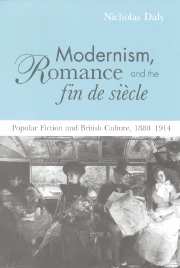Book contents
- Frontmatter
- Contents
- Acknowledgements
- Introduction
- 1 Incorporated bodies: Dracula and professionalism
- 2 The imperial treasure hunt: The Snake's Pass and the limits of romance
- 3 ‘Mummie is become merchandise’: the mummy story as commodity theory
- 4 Across the great divide: modernism, popular fiction and the primitive
- Afterword: the long goodbye
- Notes
- Index
Afterword: the long goodbye
Published online by Cambridge University Press: 23 November 2009
- Frontmatter
- Contents
- Acknowledgements
- Introduction
- 1 Incorporated bodies: Dracula and professionalism
- 2 The imperial treasure hunt: The Snake's Pass and the limits of romance
- 3 ‘Mummie is become merchandise’: the mummy story as commodity theory
- 4 Across the great divide: modernism, popular fiction and the primitive
- Afterword: the long goodbye
- Notes
- Index
Summary
When we prise the narratives of the ‘revival of romance’ loose from the Gothic tradition and consider them as part of a popular modernist culture, they appear to us under a new aspect. Narratives and figures that remain inscrutable when we try to read them through the conventions of the eighteenth-century Gothic of Walpole, Radcliffe and Lewis, yield up their meaning when read as components of the imaginary of a modern imperial society, a society increasingly characterized, as I have described, by the ideology of professional expertise and by consumerism. The mummy, the team of men, the treasure map – these are historically determinate figures, untranslatable in terms of a Gothic or Romantic lexicon of sublimity, picturesqueness and alienation. But if the modern romance is estranged from its Gothic predecessors, at times it may be more familiar to us, as in the case of Dracula, where the original text continues to be read alongside numerous adaptations, textual and filmic. Our relation to Stoker's novel is now inevitably mediated by our knowledge of these adaptations, and yet the novel continues to exert a semi-autonomous appeal. Our historical moment is not that of the romance revival, but to the extent that it retains the vestiges of a late nineteenth-century imaginary – in which, as I've argued, the professional team looms larger than the aristocratic vampire – the readerly pleasures that Stoker's tale evokes still work for us in a way that those of, say, The Castle of Otranto do not.
- Type
- Chapter
- Information
- Modernism, Romance and the Fin de SièclePopular Fiction and British Culture, pp. 149 - 169Publisher: Cambridge University PressPrint publication year: 2000

